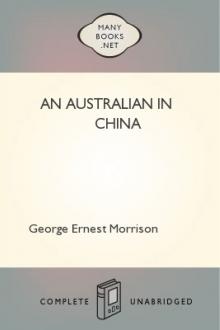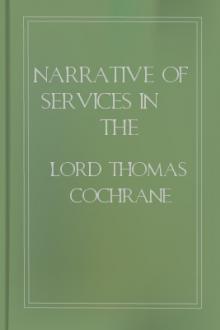An Australian in China by George Ernest Morrison (online e book reading TXT) 📕

- Author: George Ernest Morrison
- Performer: -
Book online «An Australian in China by George Ernest Morrison (online e book reading TXT) 📕». Author George Ernest Morrison
Project Gutenberg's An Australian in China, by George Ernest Morrison
This eBook is for the use of anyone anywhere at no cost and with
almost no restrictions whatsoever. You may copy it, give it away or
re-use it under the terms of the Project Gutenberg License included
with this eBook or online at www.gutenberg.org
Title: An Australian in China
Being the Narrative of a Quiet Journey Across China to Burma
Author: George Ernest Morrison
Release Date: September 4, 2006 [EBook #19172]
Language: English
*** START OF THIS PROJECT GUTENBERG EBOOK AN AUSTRALIAN IN CHINA ***
Produced by Thierry Alberto and the Online Distributed
Proofreading Team at http://www.pgdp.net
Obvious typographical errors have been corrected in this text. For a complete list, please see the bottom of this document.
M.D. Edin., F.R.G.S.
THIRD EDITION
LONDON: HORACE COX
WINDSOR HOUSE, BREAM'S BUILDINGS
E.C.
MDCCCCII
TO
JOHN CHIENE, M.D.,F.R.C.S.E., F.R.S.E., ETC.,
PROFESSOR OF SURGERY IN THE UNIVERSITY OF EDINBURGH,
WHO GAVE ME BACK THE POWER OF LOCOMOTION.
I GRATEFULLY
INSCRIBE THIS VOLUME.
Introductory—Mainly about Missionaries and the City of Hankow
1-11 CHAPTER II.From Hankow to Wanhsien, with some Account of Chinese Women and the Rapids of the Yangtse
12-23 CHAPTER III.The City of Wanhsien, and the Journey from Wanhsien To Chungking
24-34 CHAPTER IV.The City of Chungking—The Chinese Customs—The famous Monsieur Haas, and a few Words on the Opium Fallacy
35-49 CHAPTER V.The Journey from Chungking to Suifu—Chinese Inns
50-62 CHAPTER VI.The City of Suifu—The China Inland Mission, with some general Remarks about Missionaries in China
63-75 CHAPTER VII.Suifu to Chaotong, with some Remarks on the Province of Yunnan—Chinese Porters, Postal Arrangements, and Banks
76-96 CHAPTER VIII.The City of Chaotong, with some Remarks on its Poverty, Infanticide, Selling Female Children into Slavery, Tortures, and the Chinese Insensibility to Pain
97-106 CHAPTER IX.Mainly about Chinese Doctors
107-114 CHAPTER X.The Journey from Chaotong to Tongchuan
115-124 CHAPTER XI.The City of Tongchuan, with some Remarks upon Infanticide
125-134 CHAPTER XII.Tongchuan to Yunnan City
135-147 CHAPTER XIII.At Yunnan City
148-157 CHAPTER XIV.Gold, Banks, and Telegraphs in Yunnan
158-170 CHAPTER XV.The French Mission and the Arsenal in Yunnan City
171-182 CHAPTER XVI.The Journey from Yunnan City to Talifu
183-201 CHAPTER XVII.The City of Tali—Prisons—Poisoning—Plagues and Missions
202-217 CHAPTER XVIII.The Journey from Tali, with some Remarks on the Character of the Cantonese, Chinese Emigrants, Cretins, and Wife-beating in China
218-232 CHAPTER XIX.The Mekong and Salween Rivers—How to Travel in China
233-243 CHAPTER XX.The City of Tengyueh—The Celebrated Wuntho Sawbwa—Shan Soldiers
244-259 CHAPTER XXI.The Shan Town of Santa, and Manyuen, the Scene of Consul Margary's Murder
260-269 CHAPTER XXII.China as a Fighting Power—The Kachins—And the Last Stage into Bhamo
270-281 CHAPTER XXIII.Bhamo, Mandalay, Rangoon, and Calcutta
282-291 ILLUSTRATIONS.Mostly from Photographs by Mr. C. Jensen of the Imperial Chinese Telegraphs.
Introductory—Mainly about Missionaries and the City of Hankow.
In the first week of February, 1894, I returned to Shanghai from Japan. It was my intention to go up the Yangtse River as far as Chungking, and then, dressed as a Chinese, to cross quietly over Western China, the Chinese Shan States, and Kachin Hills to the frontier of Burma. The ensuing narrative will tell how easily and pleasantly this journey, which a few years ago would have been regarded as a formidable undertaking, can now be done.
The journey was, of course, in no sense one of exploration; it consisted simply of a voyage of 1500 miles up the Yangtse River, followed by a quiet, though extended, excursion of another 1500 miles along the great overland highway into Burma, taken by one who spoke no Chinese, who had no interpreter or companion, who was unarmed, but who trusted implicitly in the good faith of the Chinese. Anyone in the world can cross over to Burma in the way I did, provided he be willing to exercise for a certain number of weeks or months some endurance—for he will have to travel many miles on foot over a mountainous country—and much forbearance.
I went to China possessed with the strong racial antipathy to the Chinese common to my countrymen, but that feeling has long since given way to one of lively sympathy and gratitude, and I shall always look back with pleasure to this journey, during which I experienced, while traversing provinces as wide as European kingdoms, uniform kindness and hospitality, and the most charming courtesy. In my case, at least, the Chinese did not forget their precept, "deal gently with strangers from afar."
I left Shanghai on Sunday, February 11th, by the Jardine Matheson's steamer Taiwo. One kind friend, a merchant captain who had seen life in every important seaport in the world, came down, though it was past midnight, to bid me farewell. We shook hands on the wharf, and for the last time. Already he had been promised the first vacancy in Jardine Matheson's. Some time after my departure, when I was in Western China, he was appointed one of the officers of the ill-fated Kowshing, and when this unarmed transport before the declaration of war was destroyed by a Japanese gunboat, he was among the slain—struck, I believe, by a Japanese bullet while struggling for life in the water.
I travelled as a Chinese, dressed in warm Chinese winter clothing, with a pigtail attached to the inside of my hat. I could not have been more comfortable. I had a small cabin to myself. I had of course my own bedding, and by paying a Mexican dollar a day to the Chinese steward, "foreign chow," was brought me from the saloon. The traveller who cares to travel in this way, to put his pride in his pocket and a pigtail down his back, need pay only one-fourth of what it would cost him to travel as a European in European dress.
But I was, I found, unwittingly travelling under false pretences. When the smart chief officer came for my fare he charged me, I thought, too little. I expressed my surprise, and said that I thought the fare was seven dollars. "So it is," he replied "but we only charge missionaries five dollars, and I knew you were a missionary even before they told me." How different was his acuteness from that of the Chinese compradore who received me on the China Merchants' steamer Hsin Chi, in which I once made a voyage from Shanghai to Tientsin, also in Chinese dress! The conversation was short, sharp, and emphatic. The compradore looked at me searchingly. "What pidgin belong you?" he asked—meaning what is your business? Humbly I answered, "My belong Jesus Christ pidgin"; that is, I am a missionary, to which he instantly and with some scorn replied, "No dam fear!"
We called at the river ports and reached Hankow on the 14th. Hankow, the Chinese say, is the mart of eight provinces and the centre of the earth. It is the chief distributing centre of the Yangtse valley, the capital city of the centre of China. The trade in tea, its staple export, is declining rapidly, particularly since 1886. Indian opium goes no higher up the river than this point; its importation into Hankow is now insignificant, amounting to only 738 piculs (44 tons) per annum. Hankow is on the left bank of the Yangtse, separated only by the width of the Han river from Hanyang, and by the width of the Yangtse from Wuchang; these three divisions really form one large city, with more inhabitants than the entire population of the colony of Victoria.
Wuchang is the capital city of the two provinces of Hunan and Hupeh; it is here that the Viceroy, Chang Chi Tung, resides in his official yamen and dispenses injustice from a building almost as handsome as the American mission-houses which overlook it. Chang Chi Tung is the most anti-foreign of all the Viceroys of China; yet no Viceroy in the Empire has ever had so many foreigners in his employ as he. "Within the four seas," he says, "all men are brothers"; yet the two provinces he rules over are closed against foreigners, and the missionaries are compelled to remain under the shelter of the foreign Concession in Hankow. With a public spirit unusual among Chinese Viceroys he has devoted the immense revenues of his office to the modern development of the resources of his vice-kingdom. He has erected a gigantic





Comments (0)